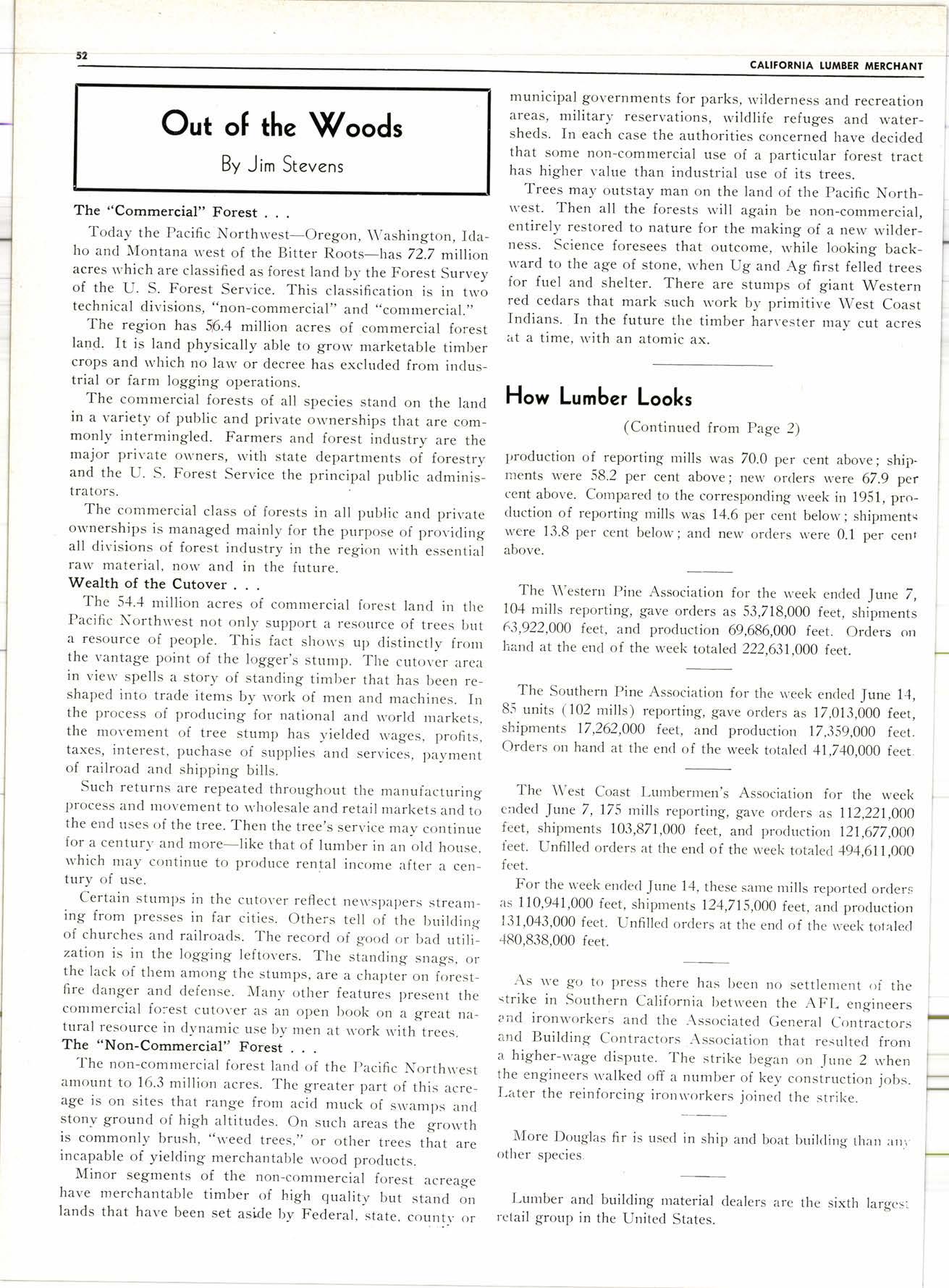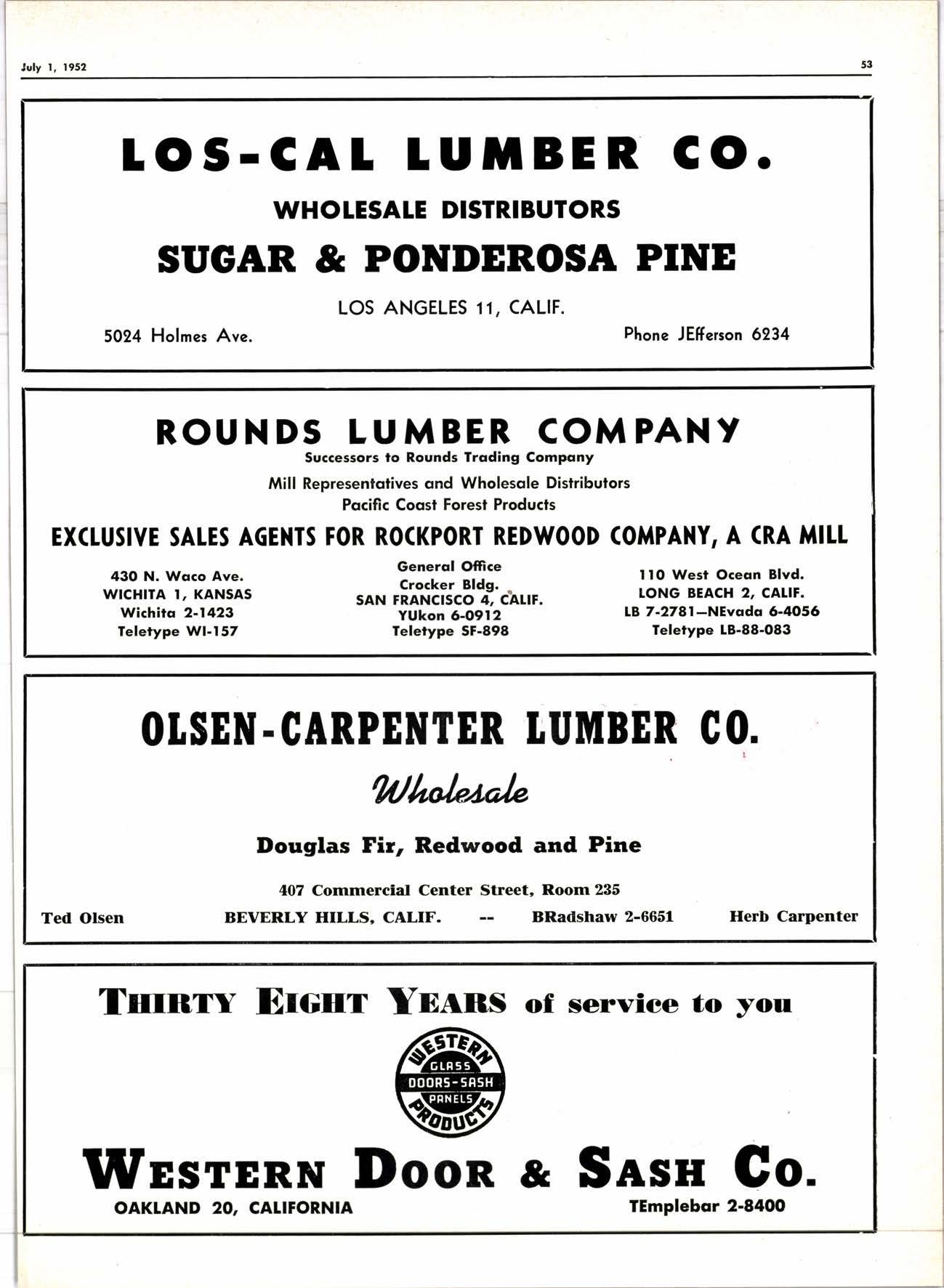
3 minute read
Out of the \(/oods
Bv Jir Stevens
The "Commercial" Forest
Today the Pacific Northrvest-Oregon, \\rashington, Idalro and N{ontana n'est of the Bitter Roots-has 72.2 million acres t'hich are classified as forest land bv the Forest Survev of the U. S. Forest Service. This classification is in tr.vl technical divisions, "non-commercial,, and,,comrnercial."
The region has 5i6.4 million acres of commercial forest land. It is land physically able to grorv marketable timber crops and rvhich no law or decree has excluded from inclus_ trial or farm logging operations.
The commercial forests of all species stand on the land in a variety of public and private orvnerships that are com_ monly intermingled. Farmers and forest industry are the major prir,ate owners, lvith state departments of forestry and the U. S. Forest Service the principal public adminis_ trators.
The commercial class of forests in all public and private ownerships is managed mainly for the purpose of pror.icling all di'isions of forest industry in the region *,ith esse'tiai raw material, norv and in the future.
Wealth of the Cutover
The 54.4 rnillion acres of comn.rercial forest land ir-r the Pacific North.'est not only support a resorlrce of trees but a resource of people. This fact sh.*'s up distinctlv fro'r the vantage point of the logger's stump. The cutover irrea in vierv spells a story of standing timl;er that has been re_ shaped into trade items by l,ork of men ancl machines. In the process of producing for national and lr,orld nrarkets, the movement of tree stump has yieldecl wag.es, profits, taxes, interest, puchase of supplies ancl services, payment of railroad and shipping bilis.
Such returns are repeated throughout the manufacturing l)rocess and movement to u.holesale and retail markets and to the e'd rrses of the tree. Then the tree's service may continue for a centur' and more-like that of lumber in an olcl house, rvhich r.nay continue to prodrrce rental income after a cen_ tury of use.
certain stumps in the cuto'er reflect ne\\rsr)ar)ers streanling from presses in far cities. Others tell of the ltuilding. of churches and railroads. The record of goocl or bad utili_ z,ation is in the logging leftovers. The stancling snags, or the lack of them among the stumps, are a chaptei on firrest_ fire danger and defer-rse. Man1, other features present the commercial foiest cutor.er as an open l>ook on a great na_ tural resource in dvnamic use bv men at *'ork *.ith trees.
The "Non-Commercial" Forest
The non-commercial forest rand of the Pacific North*'est arnount to 16.3 million acres. The greater part of this acreage is on sites that range from acid muck of srvamtrs and stony ground of high altitudes. On such areas the grorvth is commonly brush, "r,veed trees,,, or other trees thett are incapable of yielding merchantable rvood products.
Minor segments of the non-commercial forest acreage have merchantable timber of high quality but stand on Iands that have been set aside b-v Federal, state, count' or municipal governments for parks, rr,ilderness and recreation areas, military reservations, wildlife refuges and water_ sheds. In each case the authorities concerned have decided that some non-commercial use of a particular forest tract has higher r.alue than industrial use of its trees.
Trees may outstay man on the lancl of the pacific Northn'est. Then all the forests will again be non-commercial, entirely restored to nature for the making of a nelv wilder_ ness. Science foresees that outcome, rvhile looking back_ rvard to the age of stone, .ivhen Ug and Ag first felled trees for fuel and shelter. There are stumps of giant Western red cedars that mark such u,ork by primitive West Coast Indians. In the future the timber harvester may cut acres at a time, rvith an atomic ax.
How Lumber Looks
(Continued from page 2) production of reporting mills was 70.0 per cent above; shipments rvere .58.2 per cent above; nerv orders \vere 62.9 per cent above. Cornpared to the corresponding rveek in 1951, production of reporting mills was 14.6 per cent below; shipment* were 13.8 per cent below;and new orders lvere 0.1 per ceni above.
The \\'estern Pine Association for the rveek ended June 7, 104 mills reporting, gave orders as 53,718,000 feet, shipments 63,922,000 feet, and production 69,686,000 feet. Orders orr hzrnd at the encl of the week totaled 222,631,000 feet.
The Southern Pine Association for the lr,eek enclecl June 14, 8.5 units (102 rnills) reporting, gave orclers as 12,013,000 feet, shipments 17,262,000 feet, and production 17,359,000 feet. Orders on hand at the end of the week totalecl 41,740.000 feet.
The \Vest Coast Lumbermen's Association for the weel< erded June 7, 175 mills reporting, gave orclers as 112/21,000 feet, shipments 103,871,000 feet, and production 121,677,000 ieet. unfilled orders at the end of the weeli totalecl 494.611.000 feet.
For the *,'eek enderl Jrrne 14, these s:rrne rr-rills reported orcler-" as 110,941,000 feet, shiprne'ts 124,715,000 feet, and procluction I31,043,000 feet. unfillecl orders at the encl of the rveel< totarecl 480,838,000 feet.
As rt.e go to press there has ltecn no settlenrent of the strike in Southern Californi:r bet.r'een the AFI, engineers aird ironrn'orkers a'd tl.re -{ssociated General C.ntractors and Building Contractors Association that resultecl fronr a. higher-rvage dispute. The strike began on -fune 2 rvher.r the engi'eers rvalked off a number of key construction jobs. L;rter the reinforcing iroutvrtrkers joined the strike.
X ore Douglas fir is other species used in ship and boat builrling than :rrri are the sixth largr:si
I-umber and building material dealers rctail grotrp in the United States.











